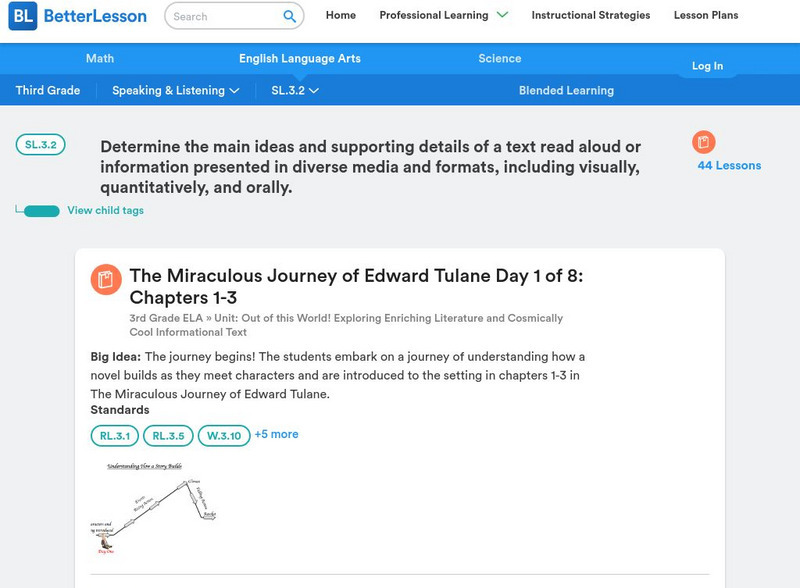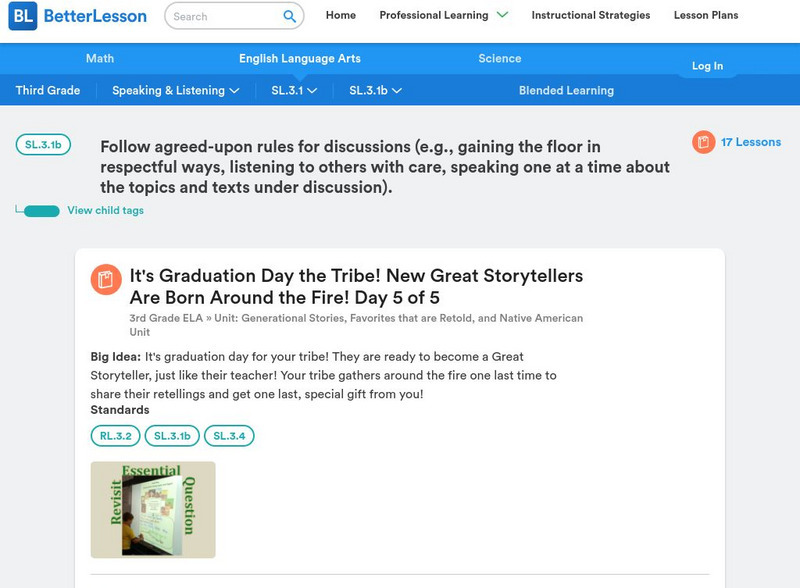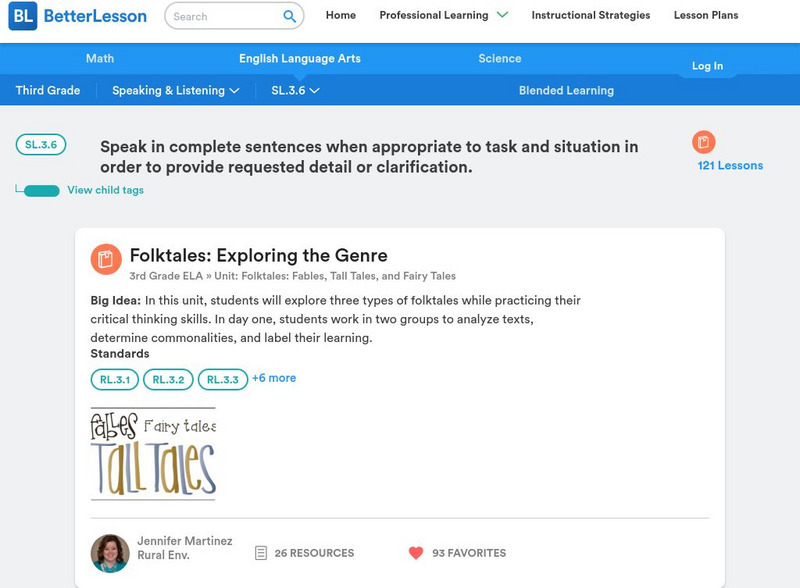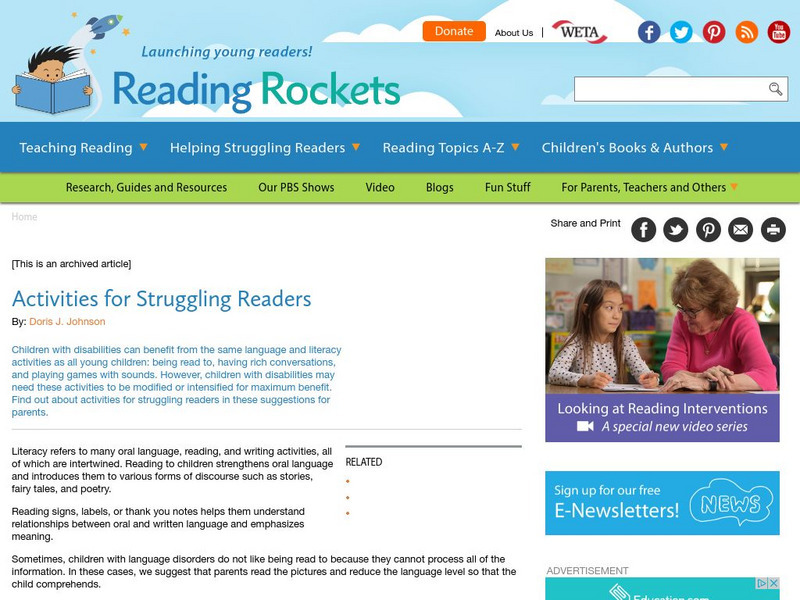Better Lesson
Better Lesson: W.3.1a: Introduce the Topic or Text They Are Writing About
Links to 12 lessons and activities that build student skills in standard W.3.1a: Introduce the topic or text they are writing about, state an opinion, and create an organizational structure that lists reasons.
Better Lesson
Better Lesson: W.3.1d: Provide a Concluding Statement or Section
Links to 11 lessons and activities that build student skills in standard W.3.1d: Provide a concluding statement or section.
Better Lesson
Better Lesson: W.3.2c: Use Linking Words and Phrases to Connect Ideas
Links to 7 lessons and activities that build student skills in standard W.3.2c: Use linking words and phrases (e.g., also, another, and, more, but) to connect ideas within categories of information.
Better Lesson
Better Lesson: W.3.2b: Develop the Topic With Facts, Definitions, and Details
Links to 12 lessons and activities that build student skills in standard W.3.2b: Develop the topic with facts, definitions, and details.
Better Lesson
Better Lesson: W.3.2a: Introduce a Topic and Group Related Information
Links to 18 lessons and activities that build student skills in standard W.3.2a: Introduce a topic and group related information together; include illustrations when useful to aiding comprehension.
McGraw Hill
Mc Graw Hill: Speaking and Listening: Respond to Ideas and Questions
Excellent guidelines for how to ask and answer questions in order to have a productive group discussion.
Better Lesson
Better Lesson: Sl.3.2: Determine the Main Ideas and Supporting Details of a Text
Links to 44 lessons and activities that build student skills in standard SL.3.2: Determine the main ideas and supporting details of a text read aloud or information presented in diverse media and formats, including visually,...
Education.com
Education.com: Sl.3.1.d Worksheets: Explain Their Own Ideas and Understanding
[Free Registration/Login Required] A site with links to 4 worksheets that can be downloaded and printed for student use while building skills with standard SL.3.1.D: Explain their own ideas and understanding in light of the discussion.
Better Lesson
Better Lesson: Sl.3.1b: Follow Agreed Upon Rules for Discussion
Links to 17 lessons and activities that build student skills in standard SL.3.1b: Follow agreed-upon rules for discussion (e.g., gaining the floor in respectful ways, listening to others with care, speaking one at a time about the topics...
Better Lesson
Better Lesson: Sl.3.6: Speak in Complete Sentences
Links to 121 lessons and activities that build student skills in standard SL.3.6: Speak in complete sentences when appropriate to task and situation in order to provide requested detail or clarification.
Reading Rockets
Reading Rockets: Activities for Struggling Readers
How can you help the struggling readers in your classroom? This site offers some insight into activities to help develop your students reading skills.
Other
New South Wales Educational Resources: Talking and Listening in K 6
Lists developmental characteristics of speech and listening of K-6 children. Excellent educational site from New South Wales.
University of Victoria (Canada)
Study Zone: Nasreddin and the Smell of Soup: Reading Comprehension
A reading passage with eight multiple-choice questions to assess reading comprehension.
Love To Know Media
Your Dictionary: Examples of Open Ended and Closed Ended Questions
Explains the difference between open and closed questions. Gives examples and situations where each might be used.
Scholastic
Scholastic Instructor: Puzzled Over Paragraphs?
Here is an excellent list of ideas for teachers to utilize in their classroom to accompany paragraph writing skills. These creative and exciting activities will sharpen your student's writing abilities.
Other
Lexiconic Resources: 5 W's and How Chart
This downloadable graphic organizer will assist students in taking notes about a news story. Students will use this resource to identify answers to the following five W's and H questions: What happened? Who was there? When did it happen?...
Alabama Learning Exchange
Alex: Narrative Paragraphs
Learners learn to use a one-main idea Think-sheet for producing a narrative paragraph. [Requires Adobe Reader.]
Alabama Learning Exchange
Alex: Descriptive Essay
Students learn to use one-main-idea think-sheets when producing simple descriptive essays.
PBS
Pbs Learning Media: Main Idea and Details Cloud
Learners practice distinguishing between relevant and irrelevant ideas by identifying relevant details in a video segment about a wild horse roundup. Students watch the video, read the transcript, and identify details they believe are...
South Carolina Educational Television
Know It All: Finding Theme
The students will be able to determine the theme of a story by recalling key details that support the theme.
South Carolina Educational Television
Know It All: Opinion Writing
Third graders will be able to form an opinion piece concerning one of their classmate's character traits and give reasons to support that opinion.
PBS
Pbs: Let's Go Luna!: Greetings From Around the World: Language Cards
Learn how to greet a friend in eight different languages
Soft Schools
Soft Schools: Reading Comprehension
Students are to read a fiction paragraph and answer a 10-question quiz about it.
Beacon Learning Center
Beacon Learning Center: Web Lessons: Get the Main Idea
This resource provides practice finding the main idea by having students read a paragraph and choose the main idea. Then it asks students to take what they have learned and apply it to a book of their choice, and then write a paragraph...



















